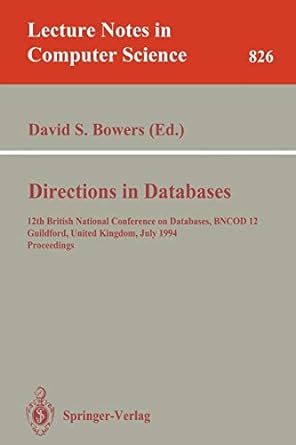Question
Show that the token-bucket leaf-storage hierarchy of 18.12 Hierarchical Token Bucket produces the same result as an internal-storage hierarchy in which each intermediate token-bucket node
Show that the token-bucket leaf-storage hierarchy of 18.12 Hierarchical Token Bucket produces the same result as an internal-storage hierarchy in which each intermediate token-bucket node contained a real, infinite-capacity FIFO queue, and each node instantaneously transmitted each packet to the parents FIFO queue as soon as it was released. Show that packets are transmitted by each hierarchy at the same times. Hint: show that each node in the leaf-storage hierarchy releases a packet at the same time the corresponding internal-storage hierarchy forwards the packet upwards.
18.12 Hierarchical Token Bucket Token-bucket filters can also be used to form a hierarchy, as in 18.7.1 Generic Hierarchical Queuing. In this section we will assume that token bucket is used only for shaping; that is, delaying packets until the bucket has sufficiently filled. As usual, packets will remain in the leaf FIFO queues until they are ready to be transmitted. Central to the hierarchy is the conceptual time each internal token-bucket node releases its next packet; that is, becomes able to inform its parent node (when asked) that it has a packet ready to send, even if the packet physically remains waiting in one of the leaf queues. If a node N is informed by a child node that a packet has been released and Ns bucket has sufficient capacity, then N releases the packet in turn to its parent immediately; otherwise N waits until its bucket fills sufficiently to make the packet compliant. When a packet arrives at a leaf node, it will be progressively released by each node along the path to the root; when it is released by the root node it can be sent. To make token-bucket filters classful, we will assume that each node may have multiple input subqueues, but treats these as if they were consolidated into a single FIFO subqueue. That is, the node releases packets to its parent in the order they were released to the node by its children. Leaf nodes can mark each packet with its release time at the moment of arrival. Interior nodes may only be able to determine their release times for packets that have been released by their child nodes. It is now straightforward to define the peek() operation of 18.7.1 Generic Hierarchical Queuing: a node looks at the set of packets it has released and returns the one with the earliest release time. In a token-bucket hierarchy it makes a sense to say that two child flows have bucket sizes of 200 and 300, respectively, while the combined flow is to be limited to a bucket size of 400. The following diagram illustrates an example of a token-bucket hierarchy. The three token-bucket filters TB1, TB2 and TB3 have rates in packets/ms and bucket sizes in packets.
TB1s rate is, as here, less than the sum of its child rates, then as long as its children always have packets ready to send, the children will receive bandwidth in proportion to their token bucket rates. In the example above, TB1s rate is 4 packets/ms and yet the sum of the rates of its children is 5 packets/ms. Each child will therefore receive 4/5 its promised rate: TB2 will send at a rate of 2(4/5) packets/ms while TB3 will send at rate of 3(4/5) packets/ms. To see this, assume FIFO2 and FIFO3 remain nonempty for a period long enough for their buckets to empty. TB2 and TB3 will then each release packets to TB1 at their respective rates of 2 packets/ms and 3 packets/ms. In the following sequence of release times to TB1, we assume TB3 starts at T=0 and TB2 at T=0.01, to avoid ties. Packets from A released by TB2 are shown in italic: 0, 0.01, .33, 0.51, .67, 1.0, 1.01, 1.33, 1.51, 1.67, 2.0, 2.01 They will be dequeued by TB1 at 4 packets/ms, once TB1s bucket is empty. In the long run, TB3 has released three packets into this sequence for every two of TB2s, so sender B will receive 3/5 of the dequeuings, and thus 3/5 of the 4 packet/ms root bandwidth. We can also have each token-bucket node physically forward released packets to FIFO queues attached to each parent node; we called this an internal-storage hierarchy in 18.7 Hierarchical Queuing. In this particular case, the leaf-storage and internal-storage mechanisms function identically, provided the internal links are infinitely fast and the internal queues infinitely large. See exercise 18. There is no point in having a node with a bucket larger than the sum of its child buckets and also a rate larger than the sum of its child rates. In the example above, in which the sum of the child rates exceeds the parent rates, A would be able to send at a sustained rate of 2 packets/ms provided B sends at only 2 packets/ms as well; reducing the child rates to 2(4/5) and 3(4/5) packets/ms respectively is not equivalent. If a nodes rate is larger than the sum of the child rates, then it will be able to handle the child traffic without delay once the child buckets have emptied. Before that, though, the parent bucket may be the limiting factor.
Step by Step Solution
There are 3 Steps involved in it
Step: 1

Get Instant Access to Expert-Tailored Solutions
See step-by-step solutions with expert insights and AI powered tools for academic success
Step: 2

Step: 3

Ace Your Homework with AI
Get the answers you need in no time with our AI-driven, step-by-step assistance
Get Started


